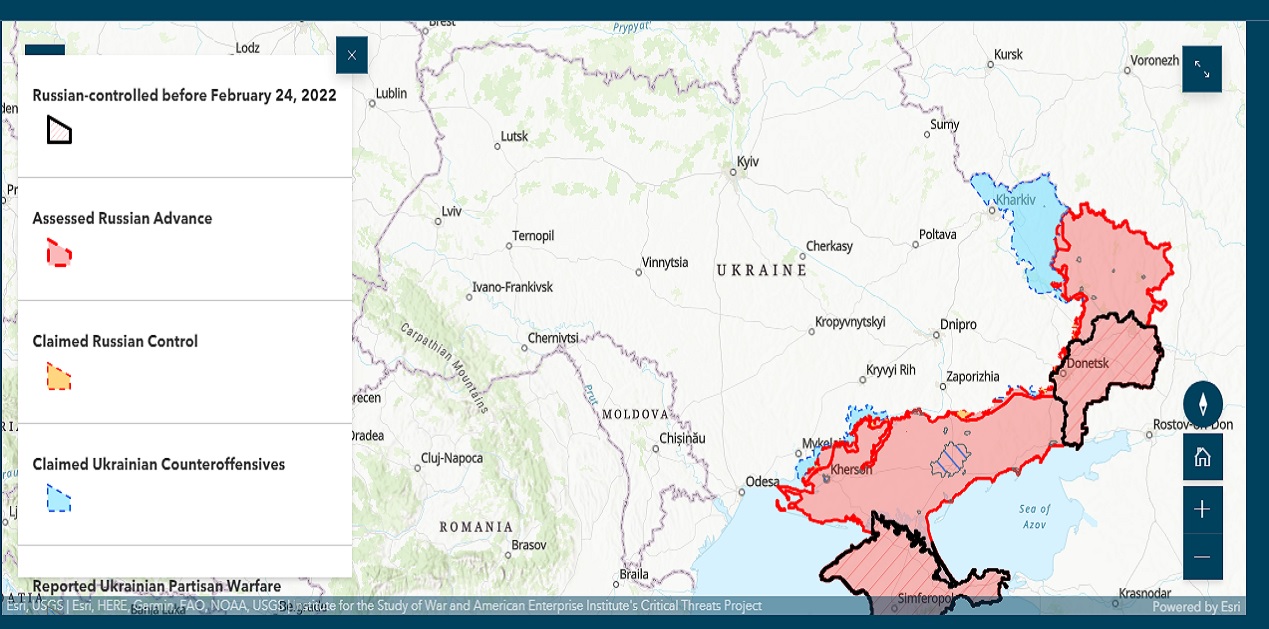On 24 February 2022, President Vladimir Putin announced ‘special military operation,’ the beginning of land, sea, and air offensive against Ukraine. The Western Pundits had forecast that the war under the onslaught of Russian famed military and technological prowess will be short, swift and lethal, forcing Ukraine to capitulate even in 48 hours! The war is a messy one, and its outcome, irrespective of the force asymmetry, cannot be guaranteed. It has been a literal see-saw, and on 21 September 2022, in a short televised address, President Vladimir Putin laid out his plans for continuation of Russia’s moves in the war in Ukraine. He declared the partial mobilisation of perhaps 300,000 reservists, referendum in Russian-occupied Ukrainian territories and thinly-veiled threat of use nuclear weapons. President Putin’s military call-up and possible nuclear threat comes days after the Ukrainian army pulled off a surprise counter offensive to recapture territory around its second-largest city, Kharkiv, in the east. On use of nuclear weapons, President Putin said “It’s not a bluff.” There are six quintessential posers that need analysis at this juncture.
The first poser is that did Russia strategically miscalculate the war? The war seemingly commenced with four strategic miscalculations on part of Russia. One, the premise that the offensive was based upon was the belief that Ukraine will capitulate soon. It was hence an attempt to politico-military coercion that failed. Two, larger hope that ethnic Russian or Russian-speaking population would rise to support Russian operation, like in city of Kharkiv, was soon belied. The Ukrainian nationalism was obviously not factored in.
Three, the hasty US withdrawal from Afghanistan in August 2021 and the Taliban takeover and the near total dependence of a number of European countries on Russian oil and gas was, presumably, taken as the West remaining diffident to an offensive against Ukraine. The strong Western, particularly the US politico-economic offensive and military support to Ukraine were obviously not planned for. And four, the initial force application of about 1,40,000 ground forces, over a near 2000 km front from Crimea to Belarus was by any military standards, an over-ambitious plan. The terrain by itself was boggy, river obstacle-ridden and highly urbanised, a very heady concoction for strategic, operational and tactical planners. For internal reasons mobilisation was not ordered in Russia, the Battalion Tactical Groups (BTGs) were by far under-strength (by some estimates 50%), and conscripts could not be deployed across the borders. Wars are messy affairs and Ukrainian Forces have planned in sectoral-terrain profiling, to undertake asymmetric, manoeuvre and attrition warfare.
Second, is the Russian end-game clarified in the 21 September speech of President Putin? On 24 Feb 2022, President Vladimir Putin explicitly denied any intention of occupying Ukraine, stating the focus was on the Donetsk and Luhansk People's Republics, the aim being to drive out Ukrainian government forces. In the clearest acknowledgment, Russian Foreign Minister Sergei Lavrov had stated in July 2022 that Moscow's military "tasks" in Ukraine now went beyond the eastern Donbas region. The Foreign Minister had stated that "Now the geography is different, it's far from being just the DPR and LPR, it's also Kherson and Zaporizhzhia regions and a number of other territories". In 21 Sep 2022 speech, President Putin had stated “…his aim to ‘liberate’ the Donbas region and that most people of the region did not want to return to the ‘yoke’ of Ukraine.”
In a slow-prod, over the period of seven months, Russian Armed Forces had achieved success in Kharkiv Oblast (less Kharkiv city), Luhansk Oblast, 60% of Donetsk Oblast including the city of Mariupol, partly Kherson Oblast including Kherson city and Antonovsky Bridge and part of Zaphorizhzhia Oblast including the Nuclear power Plant. In a major counter-offensive, Ukrainian Armed Forces recaptured Kharkiv Oblast in early Sep 2022. The Ukrainian operation was well-planned with deliberate deception of build-up against Kherson, which led to side-stepping of Russian Forces to reinforce Kherson, without fully consolidating gains in Kharkiv Oblast. What had became apparent in the seven months, is that the manpower in Russian units and reserves was at a premium, with constant side-stepping, leading to significant vulnerabilities, one of which was duly exploited.
Third will be the effect of the new mobilisation ordered. It is apparent that only military reservists, primarily those who served in the armed forces and have specific military occupational specialties and corresponding experience, will be called up in a phased manner. The recent reversal in Kharkiv, the casualties suffered, continued Western military support to Ukraine, the need to consolidate areas captured and pursuit of further gaols especially in Donetsk would have all led to partial mobilisation. In the Russian military system, units have a limited permanent cadre and reliance is on call-up of reservists to bring units to strength. Partial mobilization will tap into some of this potential power. However the initial reports have not been encouraging.
Militarily, mobilisation should have rightly been ordered in April/May 2022. Indeed the Russian Forces require the additional manpower soonest to consolidate and continue operations. Hence this mobilisation will make a difference in consolidating the front and depth lines of defence as also relieve frontline BTGs for further tasks. The quality of mobilised manpower is another issue, with the previous two-year conscripts having become over-age, unfit and ill-trained. Without going through formalised institutional training and relying only on unit training will take its toll. The tasking of the mobilised personnel will then have to be ‘managed’ well, as it can turn counter-productive.
The time-delay in this mobilisation and its phased nature does provide the Ukrainian Forces, windows of opportunity to exploit, giving rise to the appreciation of increased tempo of operations before the severe winter sets in.
Four, will there be effect of the referendum held in the four captured regions? In 2014, referendum in largely pro-Russian Crimea region was held, which formalised annexation of the Black Sea peninsula, though not recognized by most of the world. In the last week of September 2022, Luhansk and Donetsk regions intimated that referendum on joining Russia would be held. These two regions had declared their independence from Ukraine after Crimea’s annexation, triggering eight years of fighting. Hence, Donbas region may have support for the referendum, though the complete region is not under Russian control.
In the Kherson and Zaporizhzhia regions the situation is different Since Russian forces capture of parts of Kherson and Zaporizhzhia regions, Ukrainian TV broadcasts had been cut-off, replaced with Russian programming. Russian passports, rouble as currency and even Russian licence plates have been issued. However, in the southern regions, anti-Russian sentiments run strong, as Russian-appointed administrators have come under frequent attacks by Ukrainian resistance movement. The referendum is unlikely as any foundation for a peaceful transition.
The conduct of the referendum to ‘join Russia’ may allow Russian armed forces units to employ conscripts in the four regions, technically now part of the country.
Five, is there a threat of nuclear conflagration? President Putin had signalled his readiness to use nuclear weapons to protect the country’s territory. Russian military doctrine envisages using nuclear weapons in response to a nuclear attack or aggression involving conventional weapons that “threatens the very existence of the state.” Dmitry Medvedev, deputy head of Russia’s Security Council stated that after absorbing the four Ukrainian regions, Moscow could use “any Russian weapons, including strategic nuclear weapons” to defend them. Strategic nuclear forces, as against tactical nuclear weapons against Ukraine, include ICBMs and long-range bombers, with graver implications addressed to the US and the West.
This was indeed as blunt a warning as could be to Ukraine to stop pressing its offensive into the regions now set to become part of Russia. The threat of use of strategic nuclear weapons seemed as an ultimatum also to Western nations. It must however be stated that even tactical nuclear weapons (TNWs) are incredibly destructive weapons, and even their main goal remains a strategic one. There are very few scenarios in this constricted battlespace where the immense power yielded by TNWs might actually have a tactical purpose, without effecting the larger countryside and population. Their main mission hence cannot be stated as attacking military targets alone, it is largely to threaten with an aim to freeze the conflict, and stopping the threat of additional Ukrainian forays or counter-offensives like the one in Kharkiv. Usage of even TNWs might be catastrophic for the world, and would even affect the fence-sitting nations!
Six, are the events of Sep 2022 escalatory and a point of no return? Indeed, this is a valid proposition. With the effects of mobilisation, the oncoming winter and the consolidation of frontline, the war may not further escalate. However, for Ukraine, the loss of four regions also denoted by the referendum, the threat of nuclear weapons and the mobilisation ordered by Russia will be the last straw. It may well be a point of no return for the conflict, for even if there is a brokered ceasefire, the frontline will remain active and the resistance in the captured areas fine-tuned in future. The region has the potential of remaining restive for long here after, indeed a point of no return!
In sum, the transition in September 2022 has opened the Russia-Ukraine War to infinite newer possibilities. For the nations of the world, this war has dragged on for too long, and the global ramifications have been tremendous. The energy rupture itself between Russia and Europe, has been extremely costly for members of the EU with Europe attempting to re-engineer its energy framework away from Russia. The North Atlantic Treaty Organization (NATO) is admitting Sweden and Finland to its ranks, with 24 of NATO’s 30 current members having already ratified this round of enlargement. As was apparent in the SCO Meet in September 2022, India and China have also upended their stand on the War, voicing serious concerns.
At this juncture, however, the War is hurtling towards a point of no return!
(The paper is the author’s individual scholastic articulation. The author certifies that the article/paper is original in content, unpublished and it has not been submitted for publication/web upload elsewhere, and that the facts and figures quoted are duly referenced, as needed, and are believed to be correct). (The paper does not necessarily represent the organisational stance... More >>
Image Source: https://storymaps.arcgis.com/stories/36a7f6a6f5a9448496de641cf64bd375










Post new comment